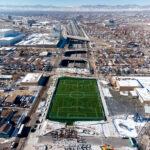
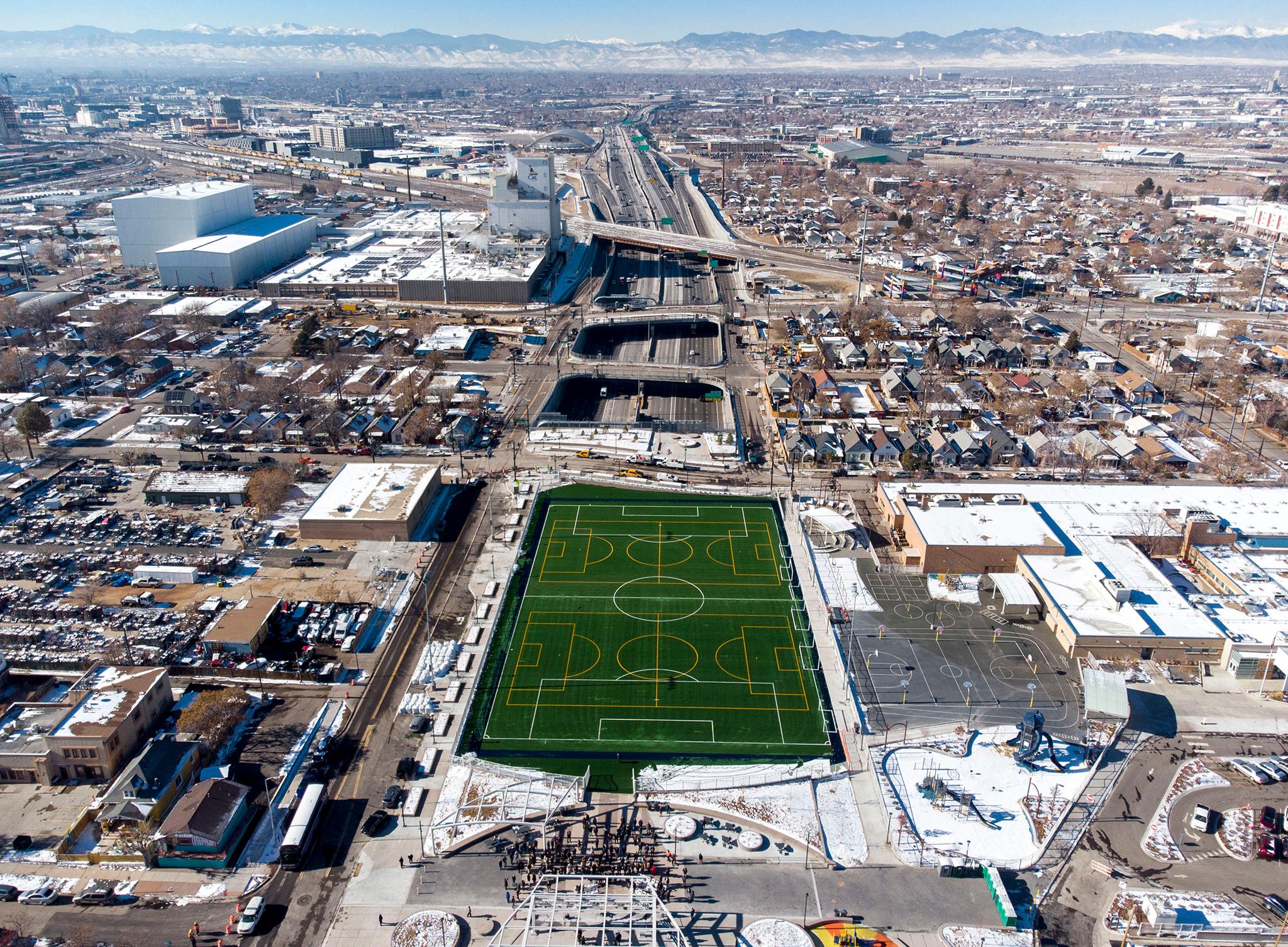
Colorado built a park over I-70 to contain pollution. Is the air safe to breathe?
By Sam Brasch

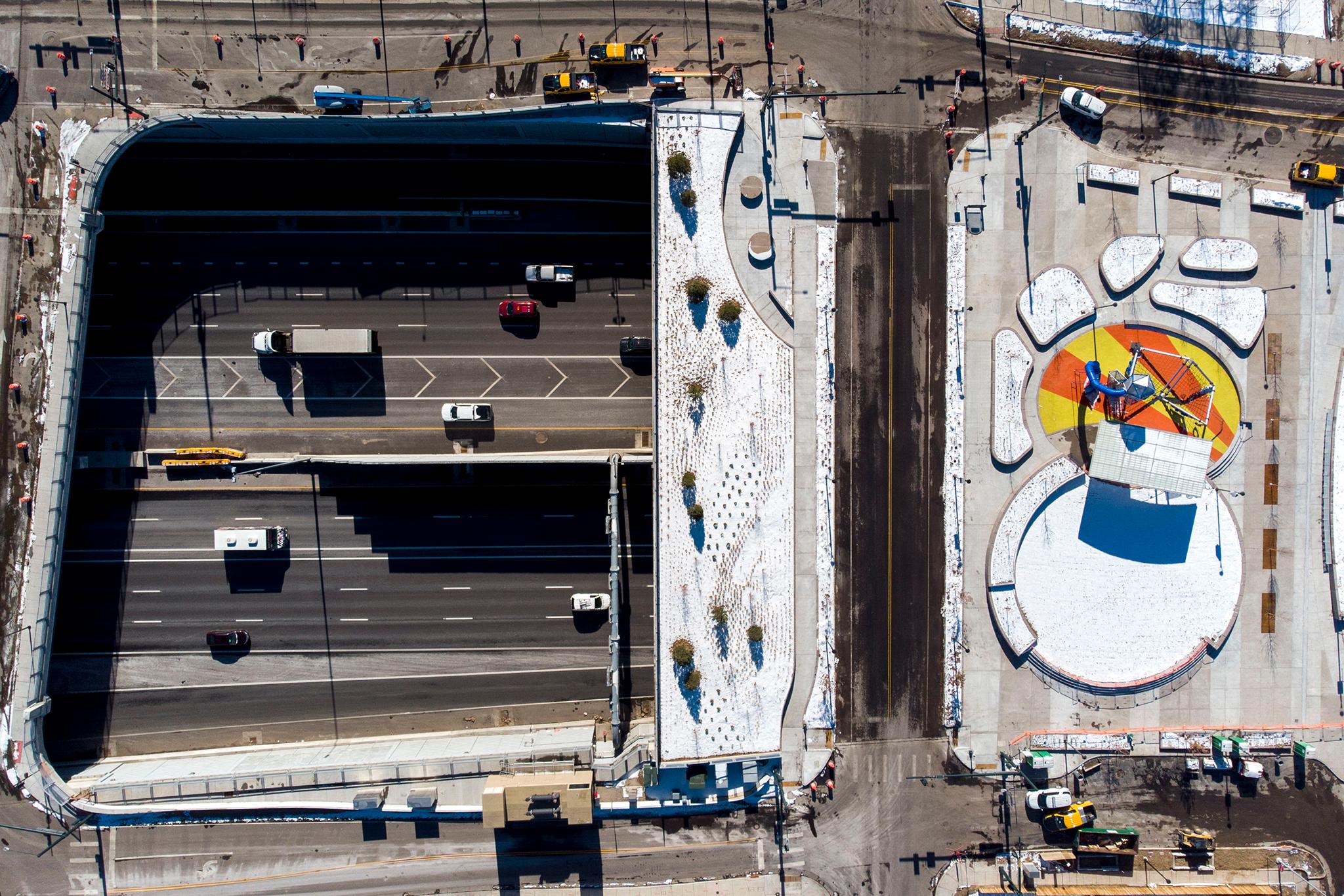
Listen to an audio version of this story
Asthma is a fact of life for Yadira Sanchez.
The longtime north Denver resident shares the condition with her three children. The chronic ailment means the family starts every morning with nasal rinses and puffs from inhalers. It’s why sports and sledding were never an option when her kids were younger. And it’s the reason she now refuses to visit a new four-acre park just blocks from her home.
The gleaming greenspace is outfitted with playgrounds, a splash pad, a soccer field and an amphitheater. Sanchez thinks it's an attractive addition to the neighborhood, but she hasn’t visited because it straddles Interstate 70, Colorado’s main east-west traffic artery.
The highway-spanning project, known as a “cap,” opened in late 2022 as the final piece of a $1.2 billion project to nearly triple the width of the thoroughfare through Elyria-Swansea — a neighborhood with some of Denver’s highest asthma rates. One reason planners added the cover was to dampen noise and pollution from the freeway below.
Sanchez, however, isn’t convinced it’s protecting anyone from toxic fumes. She worries the new park’s amenities are drawing kids and other vulnerable groups to areas with the highest risk of exposure — a concern shared by national air quality experts.
“It’s just sitting right on top of all that exhaust that’s coming up,” Sanchez said.

State and local governments have embraced a growing “cap and cover” movement pushing similar projects nationwide. By putting parks or real estate atop sunken roadways, advocates hope to reconnect communities and repair decades of damage in neighborhoods severed by urban thoroughfares.
What’s unclear is if those same caps encourage risky outdoor activity in the heart of air quality “danger zones” around highways. A growing body of research shows people living or working in such areas — typically defined as anywhere from 500 to up to 1,000 feet from a roadway — experience higher rates of asthma, heart disease, cancer and a litany of other health problems.
Colorado’s park above I-70 offers a direct opportunity to put the question to the test, but so far, no academic researchers or state authorities have directly monitored air pollution on the highway cap. To provide some initial answers, CPR News worked with a scientist at the University of Colorado Boulder to run a series of air monitors at the park.
The findings suggest some traffic emissions could be reaching the edges of the highway cap, but pollution levels in the more popular areas closer to the center were no higher than locations in the surrounding neighborhood. The findings hint the highway cap could be blocking some traffic pollution, but the data are far from definitive. Click here to read more about CPR’s air testing and methodology.
A comprehensive study could help other communities heal the wounds left by urban highways — without putting residents at risk of breathing harmful traffic pollution. It could also clarify for Sanchez and other residents, who fear the park does little to ease Elyria-Swansea’s long struggle with air pollution.
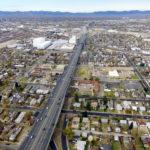
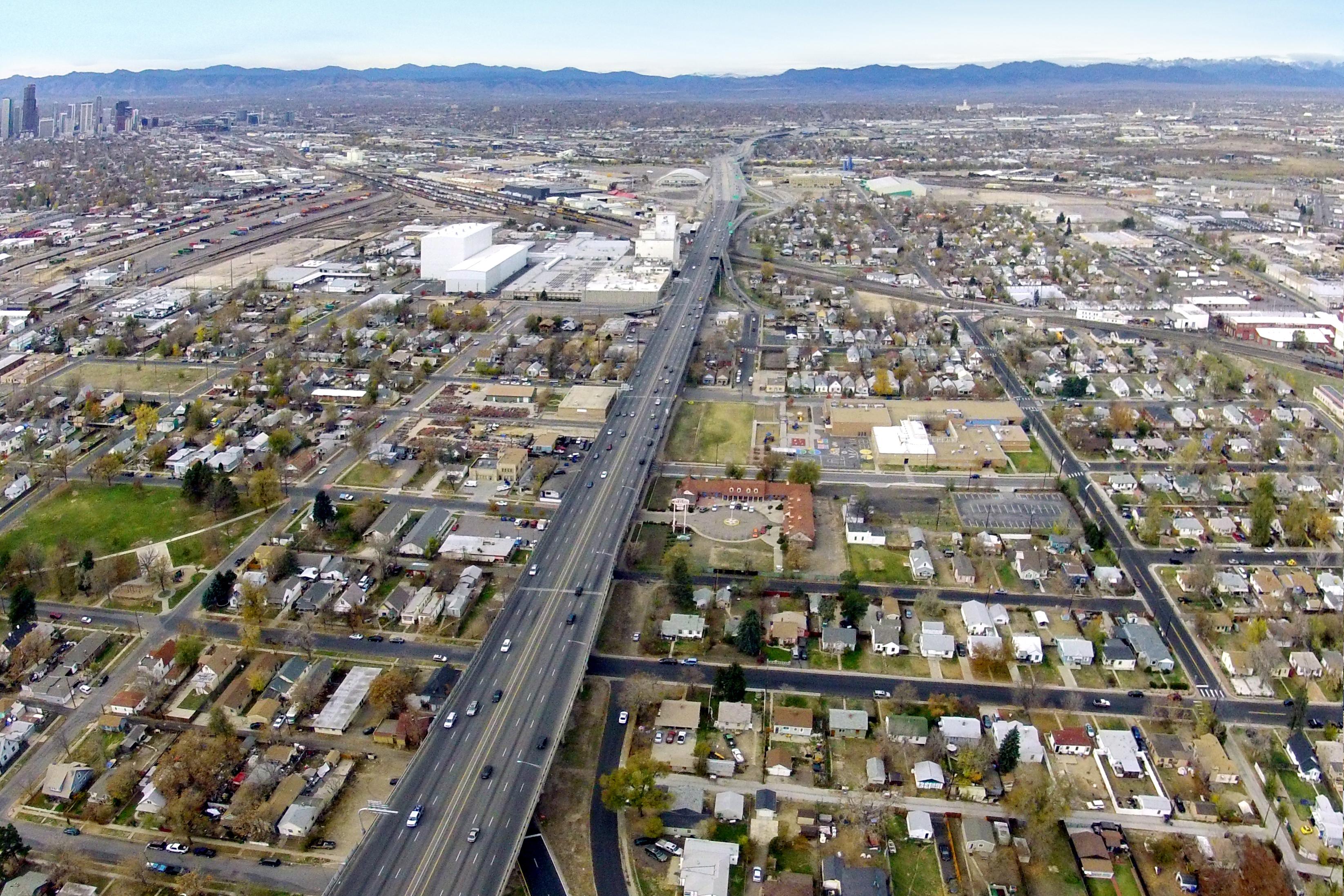
A highway through the heart of a neighborhood
The story of how I-70 arrived in the neighborhood likely sounds familiar to communities of color across the U.S.
After World War II, Elyria-Swansea was home to many working-class Black and Latino residents. In 1947, local planners identified 46th Avenue — which runs directly through north Denver — as the best location for an east-west highway to ferry motorists through the growing metro area.
State officials announced plans to build an elevated viaduct to carry I-70 along the route a decade later. Residents protested, pushing planners for a street-level design instead, but construction proceeded despite the community’s objections. The project wrapped up in 1964, destroying 31 homes in the adjacent Globeville neighborhood in the process.
In the following decades, historians documented a pattern of highways in Denver and other cities gutting lower-income communities and reinforcing racial segregation. Pollution from vehicle traffic has been a lesser-known consequence, but that’s changing. A growing body of research has identified roadways as a leading reason Black and Latino communities are more likely to breathe dirtier air than white residents.
That research later helped animate the fight against expanding I-70. As the original viaduct crumbled in the early 2000s, state officials proposed a plan to sink the highway below street level, adding toll lanes to help reduce rush hour traffic.
The Colorado Department of Transportation finalized the design in 2010. In an echo of the initial project, it required the destruction of more than 70 homes and businesses, but officials reassured residents that sinking the highway wouldn’t further divide the community. Instead, planners promised bridges and the new cover park would offer greater connectivity.
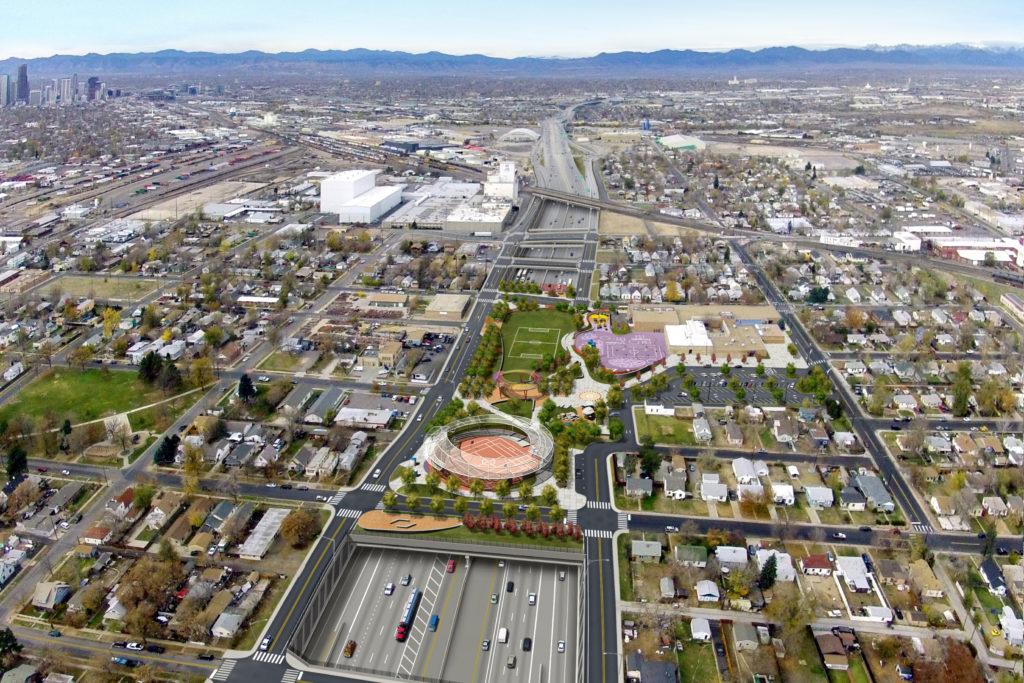
With regard to local air quality, federal and state officials claimed the project wouldn’t add to local pollution struggles. The U.S. Environmental Protection Agency published models showing pollution near the expanded highway would be “at or below” federal health thresholds. In addition, state highway planners told media outlets the project could even protect residents by cutting pollution, lowering the roadway and covering traffic with the new cover park.
Opponents were unconvinced. A 2014 study had already established people living closer to Interstate 70 experienced higher rates of asthma and cardiovascular disease. Residents feared the project would induce more car traffic and pollution through the neighborhood, exacerbating those widespread health problems.
Candi CdeBaca, a leading project opponent who later served on Denver’s City Council, said many residents were skeptical of the park from the outset, seeing it as a political attempt to “greenwash” the harmful effects of the highway expansion.
“We always called it the lipstick on a pig. It was their way to make it look less like a gash in the neighborhoods, further deepening the wound of our divide that I-70 originally caused,” said CdeBaca, who lost her council seat earlier this year.
Environmental and neighborhood groups filed a series of lawsuits challenging the state’s air quality analysis. Besides claiming the project would violate the U.S. Clean Air Act, one lawsuit demanded full consideration of an alternative plan to reroute the highway north of the city.
All those efforts proved unsuccessful. Construction began in 2018 while the legal cases were still pending. They wrapped up a few months later with a $550,000 settlement to fund additional green landscaping and a community health study. Under a separate federal requirement, the state agreed to provide low-income residents in Globeville and Elyria-Swansea with a $100 toll credit or $100 in bus passes.
Almost five years later, federal and state officials gathered for a ribbon cutting to open the new $125 million park. Ahead of the remarks, students from Swansea Elementary — located a few hundred feet away — enjoyed the new playgrounds now outside their school, their voices audible over the muted hum of the highway.
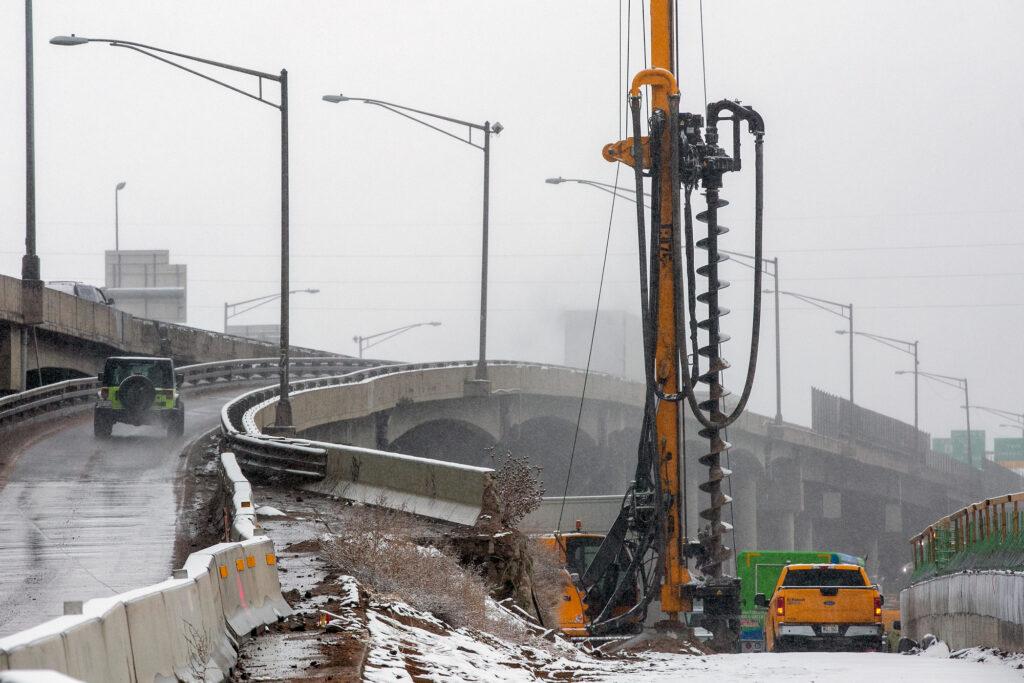
Stephanie Pollack, the acting administrator of the Federal Highway Administration at the time, told the crowd the original elevated highway viaduct was an “emblem” of unfortunate infrastructure decisions in the 1950s and 1960s. While the damage couldn’t be undone, she said Denver’s new park proved communities didn’t have to wallow in past mistakes.
“We can do across the country what we have done here in Elyria-Swansea,” she said. “Neighborhoods across the country can have this kind of reconnection and this kind of infrastructure investment.”

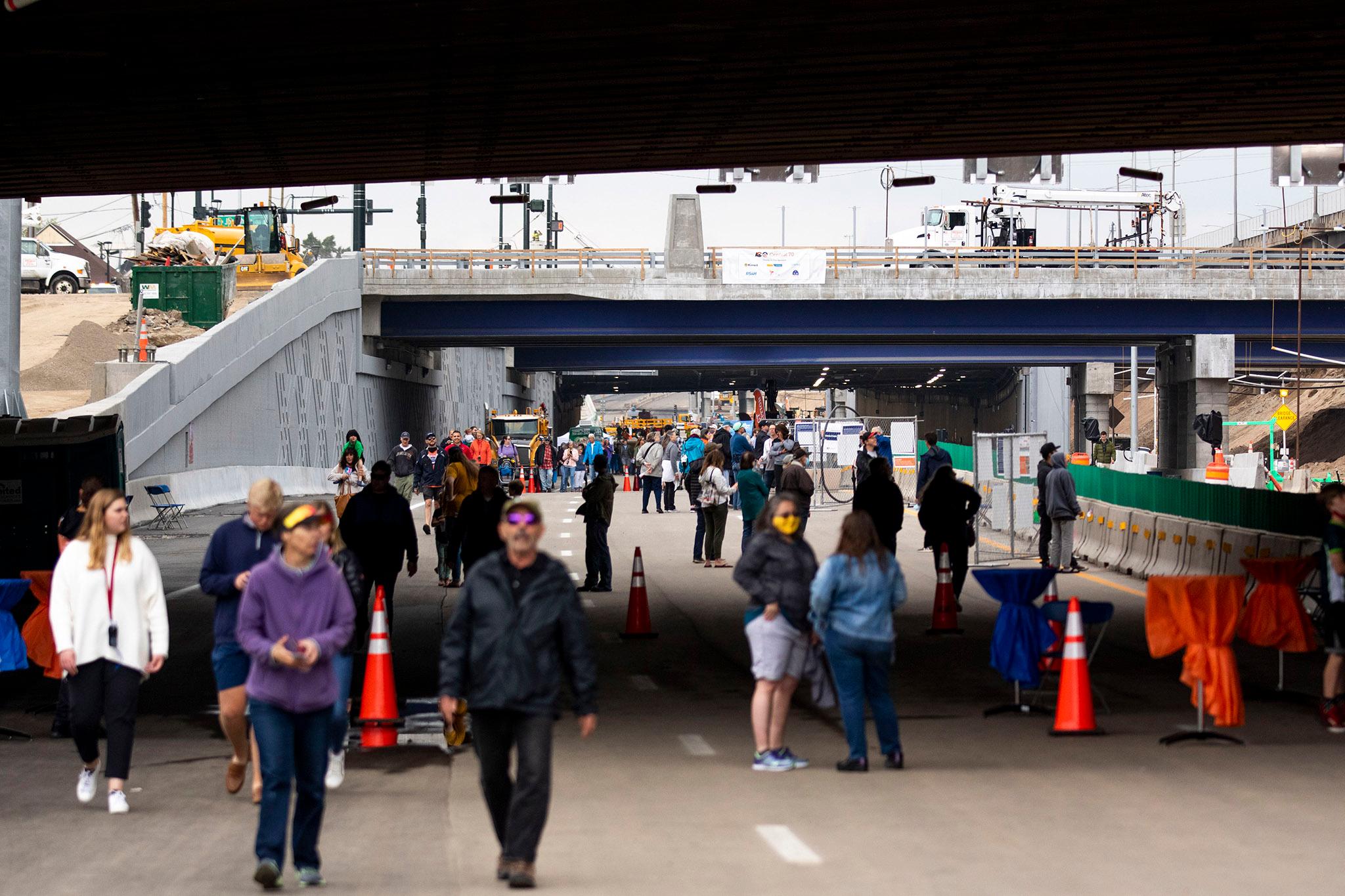
Some highway caps could offer greater protection
Since then, the federal government has launched a new $1 billion pilot program to rectify injustices caused by roadways. The first round of grants, awarded earlier this year, includes $56 million to help cover an expressway in Buffalo, N.Y.
In cities across the country, advocates and planners are now seeking support for their own projects to cover highways. In Austin, an activist group is pushing to fund a set of caps as the state expands Interstate 35 through the city. In Seattle, a plan to expand an existing cover over Interstate 5 with parks and housing has drawn adamant support from local activists. In Atlanta, a major urban renewable project called “The Stich” would cover a highway intersection with mixed-use development.
Denver officials have laid out a vision to build even more highway caps across the city to reconnect communities “dissected” by highway expansion and reduce traffic noise and air pollution. Its latest long-term mobility plan identifies seven locations where new highway caps — estimated to cost between $100 and $200 million each — could help add greenspace and connect neighborhoods, including West Washington Park, the Lower Highlands and Barnum Park.
If anyone understands the air quality risks associated with those projects, it’s Suzanne Paulson. The atmospheric scientist at the University of California Los Angeles studies how traffic pollution moves through urban environments. Her research has investigated how far highway pollution penetrates into neighborhoods and whether barriers like trees or concrete walls offer residents any protection.
While she agrees highway caps are a promising tool to connect neighborhoods and add greenspace, she said Denver’s new park should be seen as the “worst configuration” possible from an air quality perspective. That’s because the park blocks air pollution dispersion, allowing it to build up to higher concentrations before wafting out of the tunnel openings.
“This minimizes the dilution of the pollution as it escapes and delivers it to ground-level receptors — people — most efficiently,” Paulson said.
Paulson said other cap designs offer better protection by actively collecting and ventilating traffic emissions. Boston’s “big dig” is the most prominent example. While the project is infamous for its delays and budget overruns, it buried the central artery of Interstate 93 into a 1.5-mile tunnel beneath an extensive greenway cutting through the city’s center.
In addition, seven ventilation buildings regularly pump exhaust out of the tunnel through smokestacks high above street level — far from residents. After its completion in 2006, local carbon monoxide levels dropped 12 percent, a decrease the Massachusetts Department of Transportation attributes directly to the project.
During the battle over I-70, opponents called for a park design along those lines. CdeBaca said her group pushed CDOT to expand their planned highway cap to cover the entire depressed section of the highway.
A longer cap, CdeBaca and community groups argued, would not only have provided a larger physical barrier to protect air quality in the center of the park. Under federal regulations for tunnels, any enclosed section of freeway longer than 1,000 feet also requires ventilation. That means planners would have been forced to include a system to potentially move pollution away from vulnerable residents.
Highway officials declined community requests to expand the park's length, which spans just 800 feet of the roadway. In the official Record of Decision approving the project, planners said the cover was “designed to be short enough not to require artificial ventilation during normal operations.”
There is a set of turbo fans at each end of the highway cover. Matt Inzeo, a spokesperson for the Colorado Department of Transportation, said those systems only turn on when air quality declines within the tunnel due to a vehicle fire or a traffic stoppage. In other words, the system forces air into the surrounding neighborhood to protect drivers from any pollution build-up.
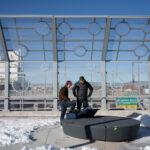
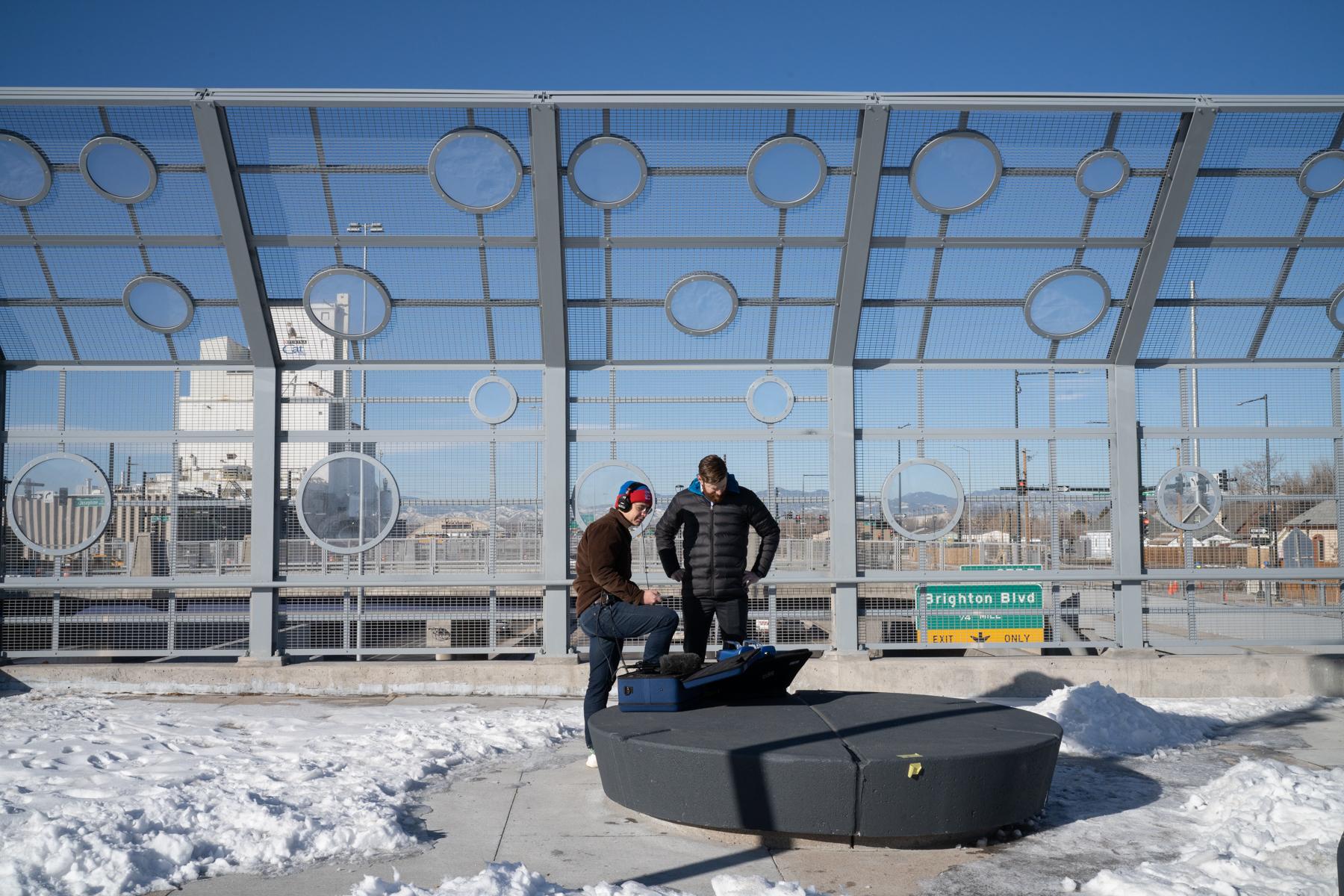
Testing the park for pollution
To gain a clearer picture of air quality at Denver’s highway cap, CPR News worked with the University of Colorado Boulder to monitor the air quality on separate days in February and June 2023.
In the first round of testing in February, a pair of monitors measured levels of ultrafine particles, tiny bits of pollution closely associated with traffic emissions. In the second round, four sensors were deployed to measure levels of PM 2.5 — a designation for larger particulates also common near highways —at the park and a control location about half a mile away.
Both rounds of testing show pollution was elevated at the edges of the park compared to downwind readings in the surrounding neighborhood. However, that difference disappeared with readings closer to the park's center, suggesting the highway cap may be helping protect the most popular areas from traffic pollution.
A long list of other factors may have influenced results. Weather and wind patterns shifted during both testing days. Other local pollution sources surround the park, including a large dog food factory and Colorado’s only oil and gas refinery. The monitors could also pick up ambient amounts of pollution unrelated to the highway.
Nick Clements, a postdoctoral air quality researcher at CU Boulder, assisted with both rounds of testing. While more conclusive results would require long-term air monitoring, he said the initial findings were encouraging. “The hints here are that it’s not alarming as it could have been,” Clements said.
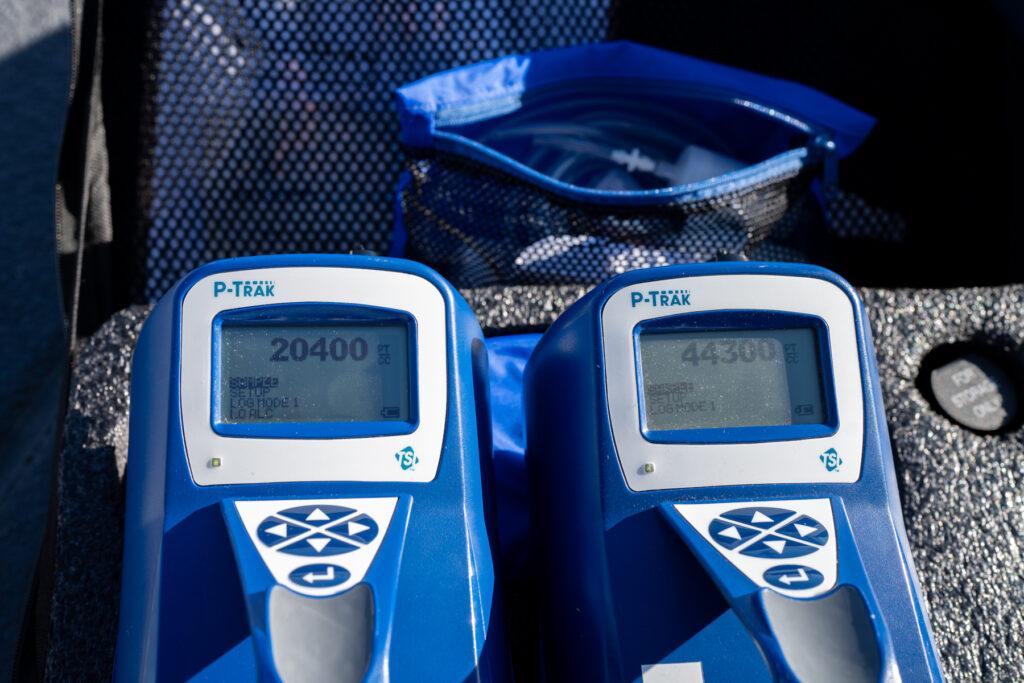
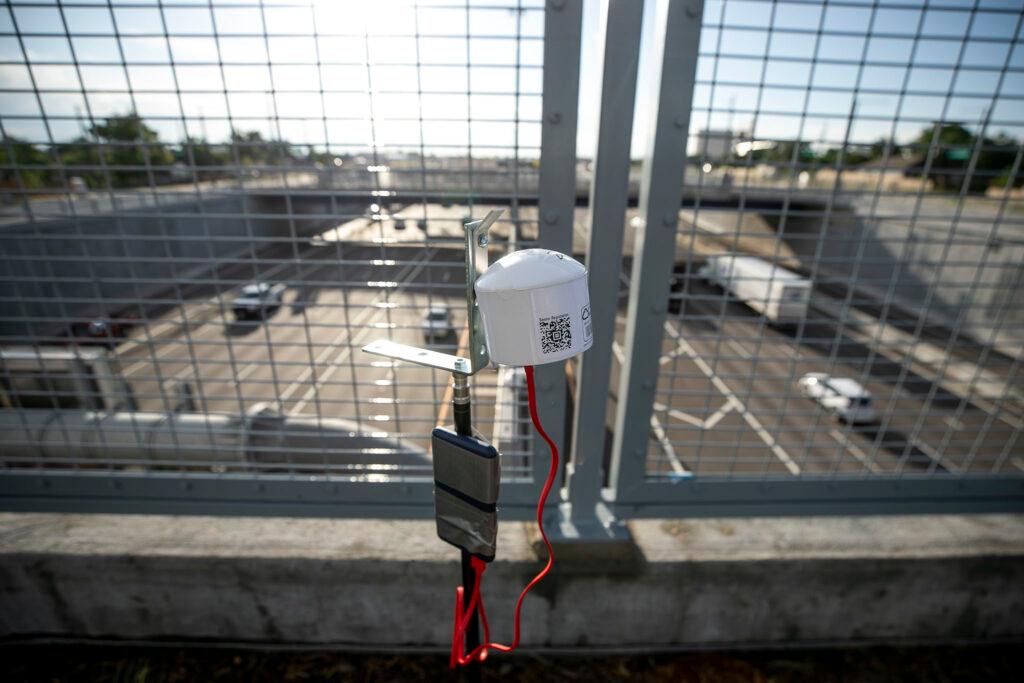
Government data offer little additional insight into whether traffic pollution is impacting the park. The closest official air monitor sits less than 100 feet north in the parking lot of Swansea Elementary School.
Bill Obermann oversees the monitor for the Denver Department of Public Health and the Environment. Since it began operating in 2017, he said it’s registered some spikes in particulate pollution linked to construction dust but has not measured levels above federal air quality standards for a range of pollutants.
While the monitor is near the park, Obermann says its readings shouldn’t be treated as an indication of air quality at the park. “We’re not monitoring directly on the deck,” he said. “The purpose of the study is not to determine if it’s safe for kids to play at the location.”
CPR News nevertheless analyzed the readings from the air quality monitor and compared it with six other Denver air quality monitors. The analysis shows that Elyria-Swansea and Globeville regularly experience the worst particulate air pollution in the city.
Whether the highway project worsened the situation is less clear. Over the last five years, readings from the Swansea Elementary monitor suggest average particulate levels are higher now than before the I-70 viaduct was torn down. However, average levels of nitrogen dioxide, a pollutant closely associated with traffic pollution, have declined since the project wrapped up late last year, CPR’s analysis shows.
The elementary school air monitor is scheduled to be switched off at the end of the year. While long-term air quality might help show the community impact of traffic along that section of I-70, Obermann reiterated that the sensor's main purpose was to monitor pollution during construction.

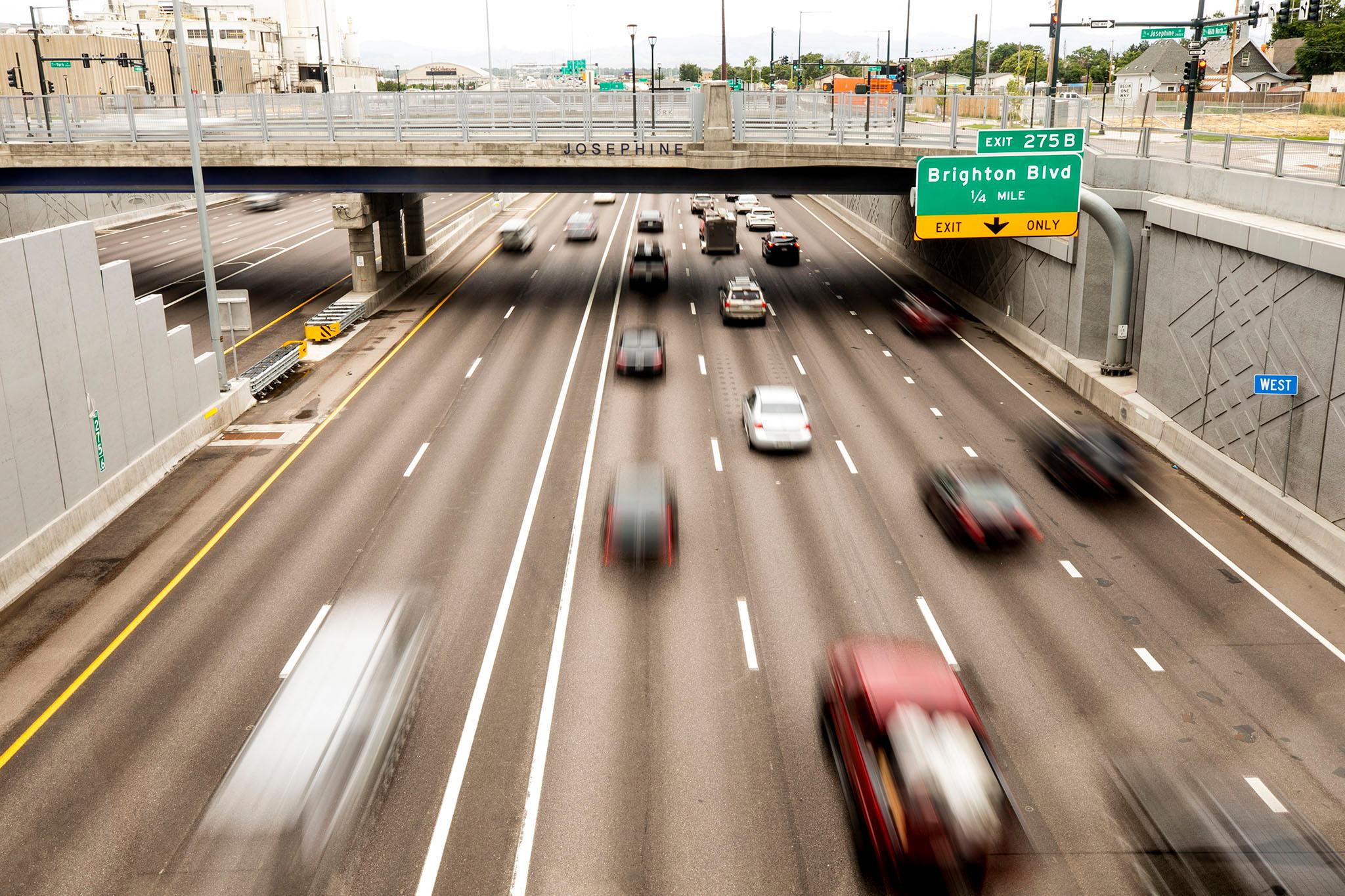
Guarding against traffic emissions
Air quality concerns are only one reason anti-highway activists now see Denver’s park as a cautionary tale.
Ben Crowther is the policy director of America Walks and coordinates the Freeway Fighters Network, a coalition pushing leaders to dismantle highways or, at a minimum, find ways to minimize the harmful effects on residents.
In his analysis, caps make the most sense as a solution for entrenched highways, such as the freeway the federal government now plans to help cover in Buffalo, N.Y. While he prefers efforts to remove freeways altogether, he recognizes that isn’t always practical due to available funding or transportation needs.
Denver’s cap simply didn’t meet those criteria, he said. The city had an option to remove the highway altogether but nixed the idea due to concerns over costs and logistics. Even then, planners chose a design without ventilation to help minimize the risk of exposure to dangerous air quality. All those reasons are why Crowther thinks other cities shouldn’t take any inspiration from Denver’s new park.
“The cap is now in an area that's likely covered by car exhaust. It’s really a meager concession, at best,” Crowther said.
The potential risk hasn’t stopped the park from becoming a popular amenity in Elyria-Swansea. On a recent fall evening, a sunset backlit dueling teams of flag football players on the artificial grass field. Nearby, Emmanuel Bruno held her infant daughter while her nieces and nephews scrambled up a playground.
It was Bruno’s first visit to the park. Her only immediate air quality concern was the pervasive smell wafting from the Nestle Purina pet food plant. Without any noticeable traffic sound, she hadn’t realized her family was now directly atop I-70.
That changed as she thought about the possibility of emissions rising toward her family.
“The park is beautiful,” she said, “ but, in the long run, how long will it last?”
Kevin J. Beaty contributed reporting.